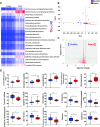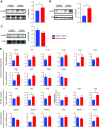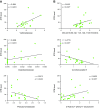Enteric dysbiosis is associated with sepsis in patients
- PMID: 31465241
- PMCID: PMC6902702
- DOI: 10.1096/fj.201900398RR
Enteric dysbiosis is associated with sepsis in patients
Abstract
Sepsis is defined as a life-threatening organ dysfunction caused by a dysregulated host response to microbial infection. For decades, the potential role of gut microbiota in sepsis pathogenesis has been revealed. However, the systemic and functional link between gut microbiota and sepsis has remained unexplored. To address this gap in knowledge, we carried out systematic analyses on clinical stool samples from patients with sepsis, including 16S rDNA sequencing, metabolomics, and metaproteomics analyses. In addition, we performed fecal microbiota transplantation from human to mice to validate the roles of gut microbiota on sepsis progression. We found that the composition of gut microbiota was significantly disrupted in patients with sepsis compared with healthy individuals. Besides, the microbial functions were significantly altered in septic feces as identified by metabolomics and metaproteomics analyses. Interestingly, mice that received septic feces exhibited more severe hepatic inflammation and injury than mice that received healthy feces after cecal ligation and puncture. Finally, several strains of intestinal microbiota and microbial metabolites were corelated with serum total bilirubin levels in patients with sepsis. Taken together, our data indicated that sepsis development is associated with the disruption of gut microbiota at both compositional and functional levels, and such enteric dysbiosis could promote organ inflammation and injury during sepsis.-Liu, Z., Li, N., Fang, H., Chen, X., Guo, Y., Gong, S., Niu, M., Zhou, H., Jiang, Y., Chang, P., Chen, P. Enteric dysbiosis is associated with sepsis in patients.
Keywords: gut microbiota; metabolomics; metaproteomics.
Conflict of interest statement
This study was supported, in part, by the National Science Funds for Distinguished Young Scholars of the Guangdong Province (2016A030306043), the Young Pearl Scholar of the Guangdong Province Award and National Natural Science Foundation of China (NSFC) (81873926 to P.C.), the NSFC–Guangdong Joint Fund of China (Grant U1601225) and Key Science and Technology Projects Program of Guangzhou City (201607020016 to Y.J.), and the Clinical Research Startup Program of Southern Medical University by High-Level University Construction Funding of the Guangdong Provincial Department of Education (LC2019ZD014 to Z.L.). Z.L., N.L., H.F., and X.C. share co–first authorship. The authors declare no conflicts of interest.
Figures






References
-
- Haak B. W., Wiersinga W. J. (2017) The role of the gut microbiota in sepsis. Lancet Gastroenterol. Hepatol. 2, 135–143 - PubMed
-
- Vincent J. L., Marshall J. C., Namendys-Silva S. A., François B., Martin-Loeches I., Lipman J., Reinhart K., Antonelli M., Pickkers P., Njimi H., Jimenez E., Sakr Y.; ICON Investigators (2014) Assessment of the worldwide burden of critical illness: the intensive care over nations (ICON) audit. Lancet Respir. Med. 2, 380–386 - PubMed
-
- Gotts J. E., Matthay M. A. (2016) Sepsis: pathophysiology and clinical management. BMJ 353, i1585 - PubMed
-
- Singer M., Deutschman C. S., Seymour C. W., Shankar-Hari M., Annane D., Bauer M., Bellomo R., Bernard G. R., Chiche J. D., Coopersmith C. M., Hotchkiss R. S., Levy M. M., Marshall J. C., Martin G. S., Opal S. M., Rubenfeld G. D., van der Poll T., Vincent J. L., Angus D. C. (2016) The third international consensus definitions for sepsis and septic shock (Sepsis-3). JAMA 315, 801–810 - PMC - PubMed
Publication types
MeSH terms
LinkOut - more resources
Full Text Sources
Medical
Miscellaneous

